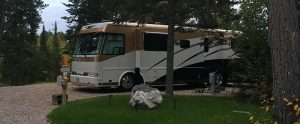 How To Get Your RV Ready To Use Again After Storing It For The Winter
How To Get Your RV Ready To Use Again After Storing It For The Winter
Chances are, your RV has been sitting unused all winter. Before RV season gets into full swing, it is a good idea to give your motorhome or trailer a thorough inspection. The time you invest in inspecting your rig is worthwhile since it can prevent a lot of headaches after you get out on the road.
Inspect The Outside Of The RV
Start your exterior inspection by walking around the entire outside of your RV, looking for any problems or signs of damage.
Take a look at your propane bottles. Has the expiration date passed? Propane bottles are designed to last for 10 years. You don’t want to find out that it is time to replace them when you take them in to have them refilled. As long as they are still usable, see how much propane you have. If necessary, refill them before you head out on the road. That way, you don’t have to worry about the propane running out when you are making a meal or trying to stay warm.
Next up is your battery. Depending on your RV, you probably have one or more 12V batteries. Reconnect them to make sure they are properly positioned.
As you walk around the outside of your RV, pay close attention to the doors, windows, and storage compartments. If you have a slide, inspect it for any problems. Take a look at the weather stripping, as well. The roof should be closely inspected to see if there are any signs of cracking or other damage. Don’t forget to check the housing for the air conditioner as well as the vent covers. At this point, connect your RV to shore power so that you can test all of the interior systems and gauges.
Take A Look At The Tires
Make sure the tires are inflated correctly and that they have an adequate amount of tread. Look closely at the sidewalls for signs of cracking or damage. The tires may be flat or slightly deflated, depending on how long the RV has been sitting. Take that into account when you begin towing the unit, starting slowly so that the tires have time to return to the correct shape. If necessary, air up the tires. You should be able to find the recommended PSI printed on each tire’s sidewall.
Start The Interior Inspection
Take a look around the interior of your RV, keeping your eyes open for signs of pests that may have taken shelter inside over the winter. As long as you properly prepared your RV for storage, the chances that any creatures got inside are slim. If you do notice signs of pests, however, you should tackle them head-on by getting rid of any nests. Inspect your unit to determine where the pests might have gotten in. That way, you can seal those areas to keep the problem from happening again. Clean your RV from top to bottom, including inside all of the cabinets.
Make Sure The Appliances Are Clean And Working Correctly
Although not all RVs will have one, if you do have a gas range, check for signs of pests by lifting the top. Inspect the refrigerator for signs of mildew. Clean it thoroughly so it is ready to go before your trip. Try using disinfecting wipes or Clorox to kill off any germs. Turn on the refrigerator for a couple of days, switching between power sources to verify that they all work correctly.
Make Sure The Safety Systems Are All Functioning
Check your smoke, carbon monoxide, and LP-gas detectors carefully to make sure they are working. Test all of your emergency exits, as well. Inspect any fire extinguishers for signs of damage.
Test The Lighting And Electrical System
Test out all of the interior lights to make sure they are in good working order. The same goes for any gadgets that you have on board. Try opening and closing your slides to make sure they are operational. Connect the water and pressurize the lines. Then, check the lines for signs of leaks. Close your tank drains and begin flushing out the lines with water if you winterized using antifreeze. As the antifreeze is washed out, it will go into your gray and black tanks. Make sure you dump the tanks at a waste disposal station that is approved for RV use.
Change out the drain plug in your water heater, replacing it with a new one. Turn the valves to normal from bypass to begin refilling the tank. If necessary, open a hot water tap so that air has a place to escape while the tank is filling.
Inspect The Propane Lines
When you turn your propane off for the winter, gas escapes from the lines. Before propane can reach your appliances again, it first needs to refill the lines. This can take some time. Check the owner’s manual for your stove and follow the instructions to light the pilot light. Allow a few minutes for the gas to make its way to the stove. After the line has been filled with propane, you should be able to start up any other appliances that operate on propane such as your furnace.
